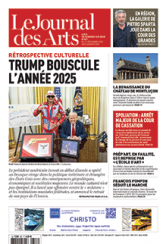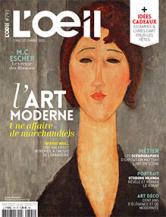Some people consider that artwork at fairs is becoming uniform. Have you noticed that?
When any practice is invested by a large number of participants, as is the case with contemporary art, it necessarily tends to become more uniform, since objectively there are not infinite possibilities for renewal and innovation. Especially when there is an increasing concentration of fairs and galleries, as is the case at the moment. Or, more precisely, it gives rise to a contradictory two-sided process that I pointed out at the end of Paradigme de l’art contemporain. Structures d’une révolution artistique (The Paradigm of Contemporary Art) (Gallimard, 2014). On one hand, a plethora of artists are seeking to exist by presenting mini-innovations, but these are only conspicuous to specialists who are capable of comparing their productions with those of their immediate predecessors. On the other hand, the very closed-circuit, self-referential character of contemporary art asserts a striking impression of uniformity, repetition, or déjà vu from an outsider point of view. That is why it is difficult to offer a unilateral answer to the question of whether things are evolving. For the insiders – initiates –, things are forever being renewed; while for outsiders – non-specialists –, they keep getting repeated.
Are you not struck by the high turnover rate of “promising young artists” launched at fairs and galleries that drop completely out of sight after a few years?
Yes, that is a completely noteworthy phenomenon which is easily explained if you take into account the strategic role of art intermediaries. For that, you have to get away from the illusion of a one-on-one interaction between artists and their works, on one side, and viewers and collectors, on the other side. Museum conservators, exhibition curators, gallery owners, and art critics are not just passive mediators between the production and reception of artwork. Each has their own professional agenda, and they especially seek to be recognised – like the artists themselves – as original by their peers, and as skilled in scouting out innovative artists who will bring attention to them. The “paradigm of contemporary art”, as I call it, is structured along the lines of uniqueness. Not just for the artists, but for every link in the chain of recognition. In order to be the first to “reveal” an artist, what better approach than to seek out that talent among the younger generation of artists who have not yet been noticed? However, as soon as they get attention, those “promising young artists” no longer interest their promoters, who must continue to distinguish themselves from their peers by revealing new talent. That means there is a real danger for an artist to no longer appeal to curators, gallery owners or critics, as soon as their time in the sun has passed. That is why young careers are running their course so quickly, leaving a number of artists out in the cold shortly after being so highly acclaimed. The world of contemporary art can be pitiless...
You just published Le Wokisme serait-il un totalitarisme ? (Is Wokism a Totalitarianism?) (Albin Michel, 2023). To what extent has contemporary art integrated the woke agenda?
The imperatives of inclusivity and diversity so characteristic of the “woke” movement are conspicuous in the significant increase of exhibitions consecrated to women, people of colour, and – when possible – women of colour. The cultural world is not exempt from this typically North American communitarian viewpoint which insists on reducing individuals to the community to which they allegedly belong, to the detriment of their personal qualities and their own individual merit. That obligation to bring visibility to certain artists – not because of their talent, but because of innate characteristics for which they are not responsible, such as sex, skin colour, or sexual orientation – is coupled with taboos of certain words (such as “negro”) and of certain representations in the name of combating cultural appropriation (proscribing the use of resources taken from other cultures). But that constitutes a crude misunderstanding of the very process of creation, which is always about hybridisation, inspiration and borrowing from elsewhere. This mixture of obligation and proscription gives rise to an atmosphere of censorship and self-censorship that can only bring to mind the humourless days of Stalinism. And the fear of being considered “conservative” keeps people from rising up and protesting against this new obscurantism, despite that it is asserted in the name of progressive values such as the struggle against discrimination. Academics are being taken by storm by this new zeitgeist, as is the media, the political world, and the professional world... And unfortunately, the art world is no exception.
How do you explain the apparent paradox between the transgressive and anti-capitalist spirit of certain works of contemporary art, and the way they are reclaimed by the luxury market and/or industry?
Whenever artwork is created to fulfil a demand – whether on the part of buyers on the private market or specialists in the institutional sphere –, they will almost inevitably be reclaimed in that way, however transgressive they are. Paradoxically, they are even more prone to being reclaimed if they are transgressive. That is what I named the “permissive paradox” in Le Triple Jeu de l’art contemporain (Éditions de minuit, 1998). Since contemporary art is defined by its ability to overstep boundaries – whatever those boundaries might be –, its recognition by specialists can only lead to the broadening of the accepted frontiers between art and non-art. That includes transgression, therefore, and implies the obligation for artists to continue delving further and further into transgression if they want to remain in the game. That creates a three-way dynamic among transgression in art, reception by audiences, and integration by the institutions and the market. The dynamic of distinction does the rest: when people have a lot of money to spend and a desire to stand out, they turn to remarkable products that are therefore showcased on the market. Whatever the motivations of the artists might be, however “anti-establishment” they might be.
Purchasing contemporary art has become a lifestyle for a number of rich collectors. How long will that last?
As long as there are new categories of objects or practices that are distinctive of a lifestyle, doubled with the contradiction between the determination to stand out and the desire to fit in with the group; in other words, as long as the concept of fashion exists.
Cet article a été publié dans Le Journal des Arts n°618 du 6 octobre 2023, avec le titre suivant : Nathalie Heinich, sociologist: “an atmosphere of censorship and self-censorship”









